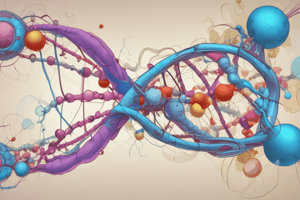Podcast
Questions and Answers
Which of the following is NOT one of the four crucial characteristics that a molecule must exhibit to serve as genetic material?
Which of the following is NOT one of the four crucial characteristics that a molecule must exhibit to serve as genetic material?
- Storage of information
- Expression of stored information
- Complex structure (correct)
- Replication
DNA is capable of encoding gene products and storing diverse information.
DNA is capable of encoding gene products and storing diverse information.
True (A)
Who published the work proving that the transforming principle in bacteria is DNA?
Who published the work proving that the transforming principle in bacteria is DNA?
Avery et al.
What was the main finding of Griffith's critical experiment with Streptococcus pneumoniae?
What was the main finding of Griffith's critical experiment with Streptococcus pneumoniae?
What molecule served as the 'transforming principle' in Avery's experiment?
What molecule served as the 'transforming principle' in Avery's experiment?
The protein coat of bacteriophage T2 is injected into the bacterial cell during infection.
The protein coat of bacteriophage T2 is injected into the bacterial cell during infection.
The central dogma of molecular genetics states that DNA makes _____, which makes proteins.
The central dogma of molecular genetics states that DNA makes _____, which makes proteins.
In which year did the Hershey-Chase experiment take place?
In which year did the Hershey-Chase experiment take place?
Study Notes
Properties of Genetic Material
- Genetic material must exhibit replication, meaning it can be copied during mitosis and meiosis.
- It must store information, encoding gene products and transmitting diverse information to progeny cells.
- The material needs to express stored information, following the central dogma where DNA converts to RNA, which then encodes proteins.
- Genetic variation is essential; mutations can be inherited and distributed within populations.
Initial Preference for Proteins
- Proteins were regarded as better candidates for genetic material because of their diversity and abundance.
- Extensive prior knowledge existed regarding proteins compared to the understanding of nucleic acid chemistry.
- Levene's tetranucleotide hypothesis incorrectly suggested equal ratios of DNA bases A, C, G, and T, disproven by Erwin Chargaff's findings.
Evidence Supporting DNA as Genetic Material
- 1944: Avery et al. published findings that identified DNA as the "transforming principle," crucial for heredity in bacteria.
- 1927: Griffith's experiment laid the groundwork for Avery, demonstrating virulence in Streptococcus pneumoniae through strain experimentation.
- Griffith used IIR (non-virulent) and IIIS (virulent) strains; injected both into a mouse expecting survival but led to the mouse's death.
- He discovered live S-strain bacteria in the dead mouse, concluding that the R-strain had been transformed by the S-strain, coining it the "Transforming principle."
Avery et al. Experiment (1944)
- Avery identified DNA as the agent that transformed non-virulent strains to virulent ones, confirming its role in heredity.
- Conducted experiments isolating various cellular components from virulent strains—only DNA achieved transformation.
Hershey-Chase Experiment (1952)
- Focused on Escherichia coli and its bacteriophage T2, illustrating that DNA carries genetic information.
- The experiment involved the structure of phages: a DNA core enveloped by a protein coat.
- Upon phage infection, only DNA penetrated the bacterial cell, leaving the protein coat outside, affirming DNA as the genetic material.
Studying That Suits You
Use AI to generate personalized quizzes and flashcards to suit your learning preferences.
Related Documents
Description
Dive into the intricate details of DNA structure and analysis as covered in Genetics 244, Chapter 10. This chapter emphasizes the properties of genetic material and is crucial for understanding the module's context. Prepare thoroughly to succeed!




